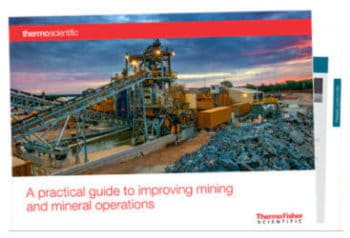This technical poster was presented at St. John’s 2012 GAC-MAC joint annual meeting . [The Geological Association of Canada (GAC®) and the Mineralogical Association of Canada (MAC)]
Application of the Thermo Scientific Niton portable XRF analyzer in geochemical exploration: An example from the Francisco I. Madero Zn–Pb–Cu–(Ag) deposit, Zacatecas, Mexico
Francisco I. Madero is a Zn–Cu–Pb–(Ag) deposit owned by Peñoles and operated as an underground mine in Zacatecas, central Mexico. Historical production up to 2011 is 23.1 Mt of ore containing 12.8 MOz Ag, 92.09 kt of Pb, and 623.9 kt of Zn.
The deposit consists of several mineralized zones located around a dome-type structure (laccolith) probably generated by forceful emplacement of an intrusive body at depth which shows a wide magnetic and gravimetric anomaly; however, the only intrusive rocks found in the mineralized area are a few Tertiary, post-Laramide dikes. The mineralized area is ~10 km2 with several ore bodies located in the same stratigraphic unit from 30 to 690 m in depth. The stratabound ore bodies are hosted by the Mesozoic back-arc marine sedimentary rocks, suggesting a syngenetic submarine exhalative genesis as sedimentary exhalative (SEDEX) or volcanogenic (VMS). However, calc-silicate mineralogy and replacement textures within calcareous units, and the absence of exhalites or identifiable feeder zones favors distal skarn model.
There are two types of sulfide ore assemblages in the ore body:
- Pb-Zn sulfides as NW trending 6-65 m thick masses composed of bands and laminations of sphalerite and galena cut by quartz, clay-pyrite and chlorite-epidote veins at the base of the ore body in an area of 6 km2, and
- Cu-Ag sulfide assemblage consists of chalcopyrite, pyrite, cubanite, enargite, and tetrahedrite as laminations and bands in 3-40 m thick ore masses cut by quartz-pyrite-chalcopyrite veinlets.
To compare assay results from different analytical methods and investigate application and efficiency of portable x-ray fluorescence (XRF), three types of analyses were carried out on drill core samples. These methods include in-house Madero atomic absorption (AA), ALS inductively coupled plasma emission spectroscopy (ICP-ES), and Thermo Scientific™ Niton™ portable XRF (Niton XL3t and Niton FXL on pulp samples).
The study shows high correlation between data from portable XRF and lab methods. Cu correlation between XRF-Niton XL3t and ICP method is 0.92 whereas this correlation between XRF-Niton FXL and AA method is 0.96. Similar correlation for Zn assayed by the same instruments yield 0.983 and 0.982 for the core samples of this ore deposit. This correlation drops to 0.87 for Ag. Lead shows the highest correlation (0.99) among the elements that were analyzed by portable XRF and AA or ICP methods.
Systematic analyses of core samples by these three methods and comparative studies indicate that geochemical anomalies for metals of interest in this deposit (Zn-Pb-Cu-Ag) can be identified readily in real time using portable XRF in the field.







Leave a Reply